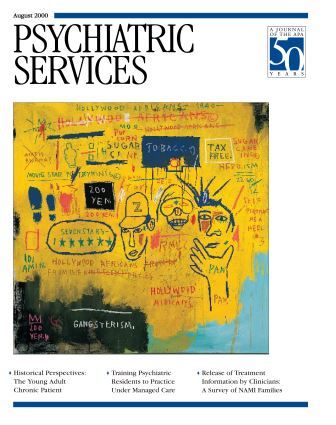Medicare's Mental Health Coverage
In Reply: Dr. Hennessy's main criticism focuses on our view that payment restrictions for mental health services under Medicare can have serious consequences for patients. Despite important strides toward parity in mental health coverage under Medicare since the 1980s, spending in this area remains relatively low, highlighting the deficiencies in the system. For example, Medicare places lifetime limits on inpatient days for mental disorders treated in psychiatric hospitals but not in general hospital settings. Exempting one type of facility but not another from lifetime coverage is clinically arbitrary at best and adversely affects utilization of needed services at worst.
Our greatest concern is that Medicare provides only 50 percent coverage for psychotherapy services, a serious disparity with general medical services. Studies have demonstrated that higher prices decrease utilization of outpatient mental health services compared with other outpatient services (1,2). It is apparent that this level of coverage serves as strong incentive for underutilization of outpatient psychotherapy by older individuals, particularly those on fixed incomes without supplementary coverage. This benefit structure not only provides a striking disincentive for comprehensive treatment, but it also ignores the efficacy of psychotherapy coupled with medication in treating late-life psychiatric illnesses, particularly affective disorders (3).
Dr. Hennessy concludes that Medicare cost limitations do not necessarily represent a serious deterrent to care on the basis of our finding that 80 percent of respondents age 65 and over would choose to receive mental health care from a primary care physician or psychiatrist. However, the fact that an individual is able to identify a provider for care does not ensure that he or she will actually receive the most appropriate care in terms of quality, amount, or specificity.
In light of the U.S. Surgeon General's recent report indicating that half of Americans who have a severe mental illness do not seek treatment (4), we believe that any gaps in benefits could have significant ramifications for individuals as well as for society. Thus we stand by our original conclusion that the disparities in Medicare coverage of mental health services are significant and may induce underutilization of necessary services to the detriment of those in need of care.
1. Shea D: Economic and financial issues in mental health and aging. Public Policy and Aging Report 9(1):7-12, 1998Google Scholar
2. Keller E, Manning W, Wells K: The demand for episodes of mental health services. Journal of Health Economics 7:369-392, 1998Crossref, Google Scholar
3. Reynolds CF 3rd, Frank E, Perel JM, et al: Nortriptyline and interpersonal psychotherapy as maintenance therapies for recurrent major depression: a randomized controlled trial in patients older than 59 years. JAMA 281:39-45, 1999Crossref, Medline, Google Scholar
4. Mental Health: A Report of the Surgeon General. Rockville, Md, Center for Mental Health Services and National Institute of Mental Health, 1999Google Scholar



